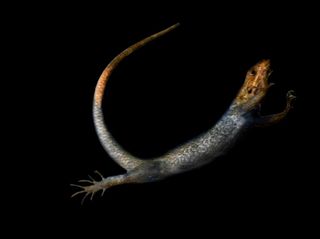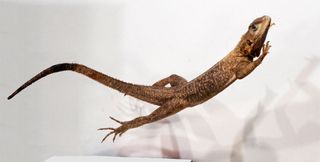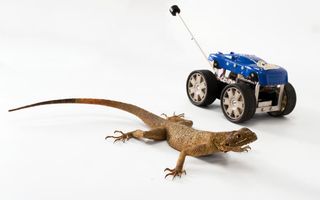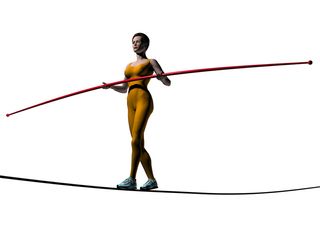Image Gallery: Acrobatic Tricks of Lizards & Robots
Expert Jumper

The red-headed Agama lizard (Agama agama) is an expert jumper, known for its ability to land such leaps safely.
Vertical Leap

Scientists took video of the red-headed Agama lizard making running leaps toward a vertical wall. The horizontal platforms they jumped from had varying surfaces, from slippery to sandpaperlike.
The Experiment

Researchers conduct their leaping lizard experiment, video-recording the Agama lizard taking leaps toward a vertical wall. Shown from left to right: Evan Chang-Siu, Daniel Cohen, Ardian Jusufi, Thomas Libby and Deborah Li.
Leaping Lizards

A red-headed African Agama lizard swings its tail upward to prevent forward pitching after a slip during take-off. Researchers have found that predatory dinosaurs like Velociraptor likely used their tails for such stability, making them quite the acrobats.
Lizard & Bot

A red-headed Agama lizard stands beside Tailbot, a simple car equipped with an actively controlled tail that can quickly right itself in midair even when dropped nose-down.
Velociraptor Tail

A lizard (Agama agama) with the Tailbot robot and a model of Velociraptor (Discovery Channel 4D Anatomy Model, 2008 Fame Master Ent. Ltd.).
Tightrope Walker

Researchers think raptors as well as today's lizards use their tails much as tightrope walkers use balancing poles (tilting the pole to make their bodies lean in the opposite direction of the tilt). The extinct reptiles would have bent their tails to control the orientation of their bodies as they leapt.
Sign up for the Live Science daily newsletter now
Get the world’s most fascinating discoveries delivered straight to your inbox.
Red-Headed Agama

Here, an Agama agama lizard photographed in the wild in Tsavo national park, Kenya.
Most Popular



